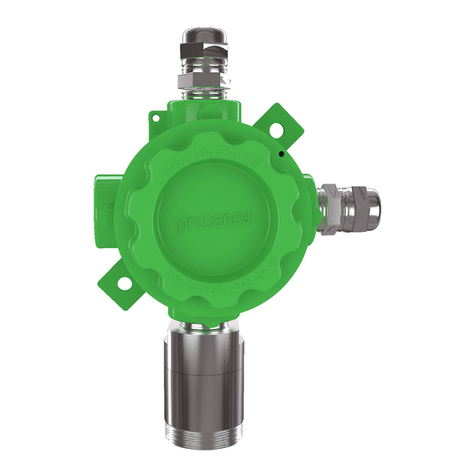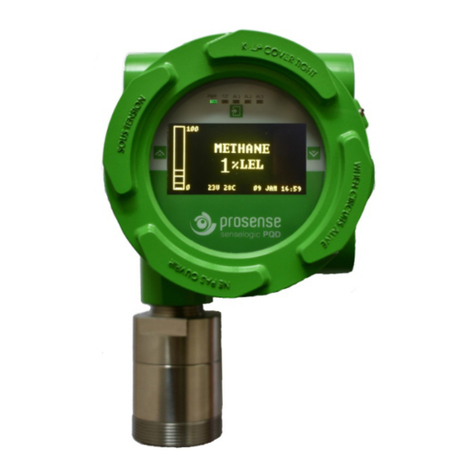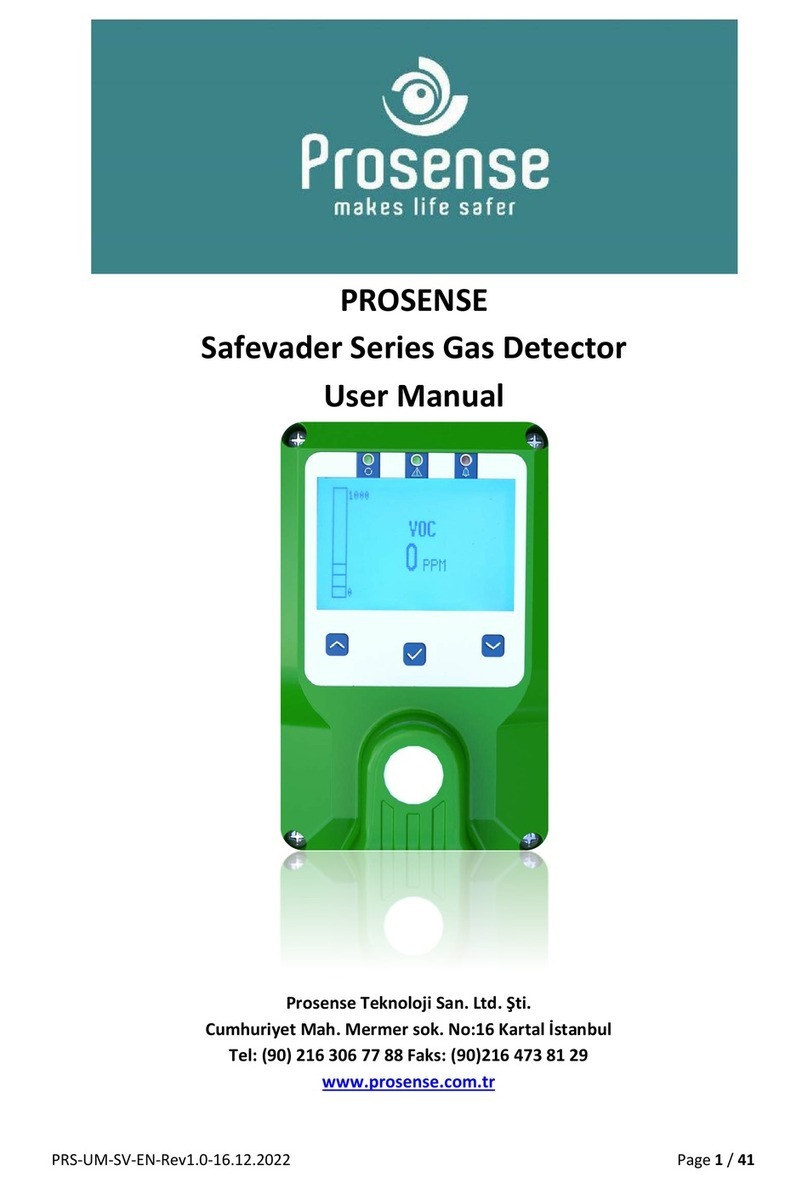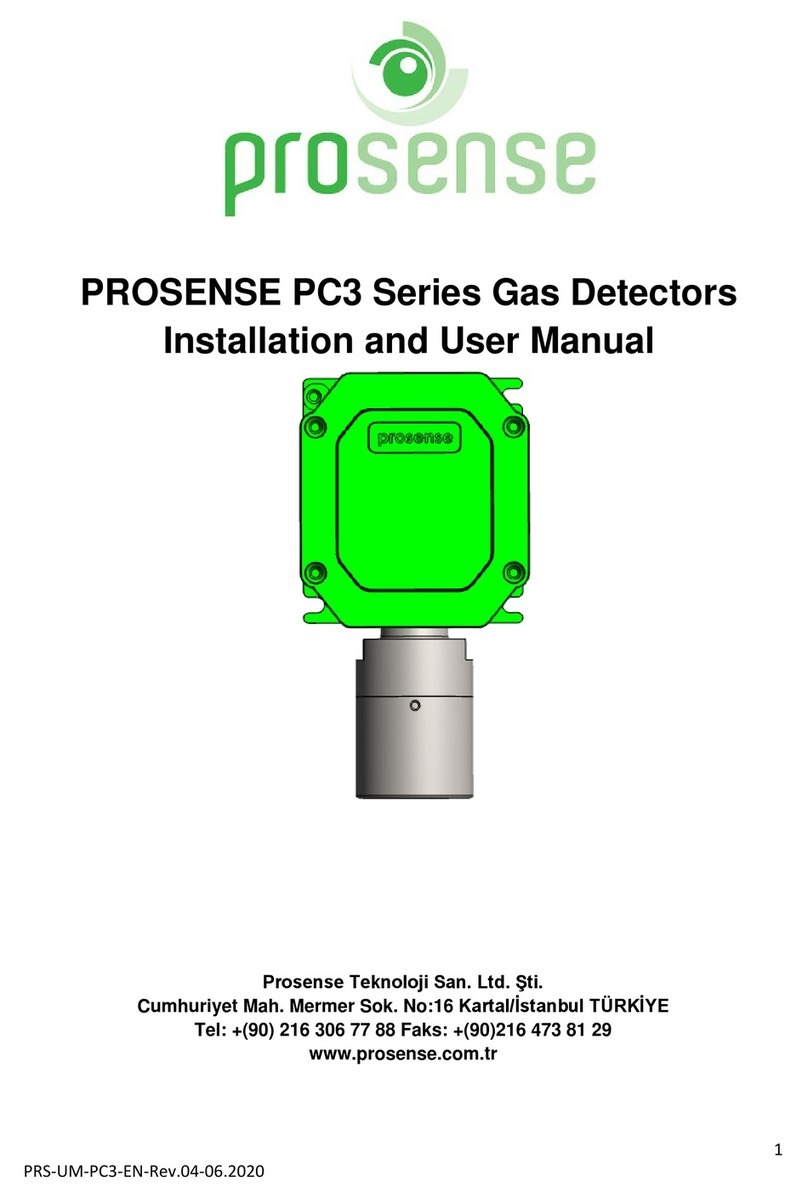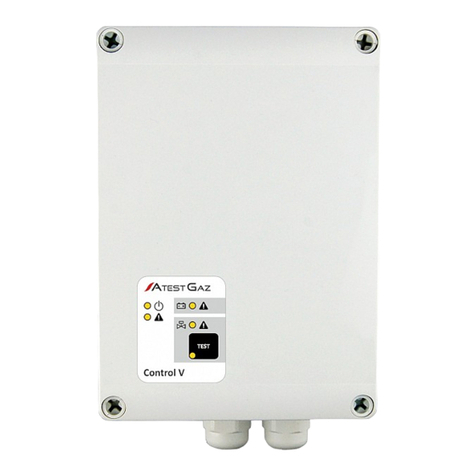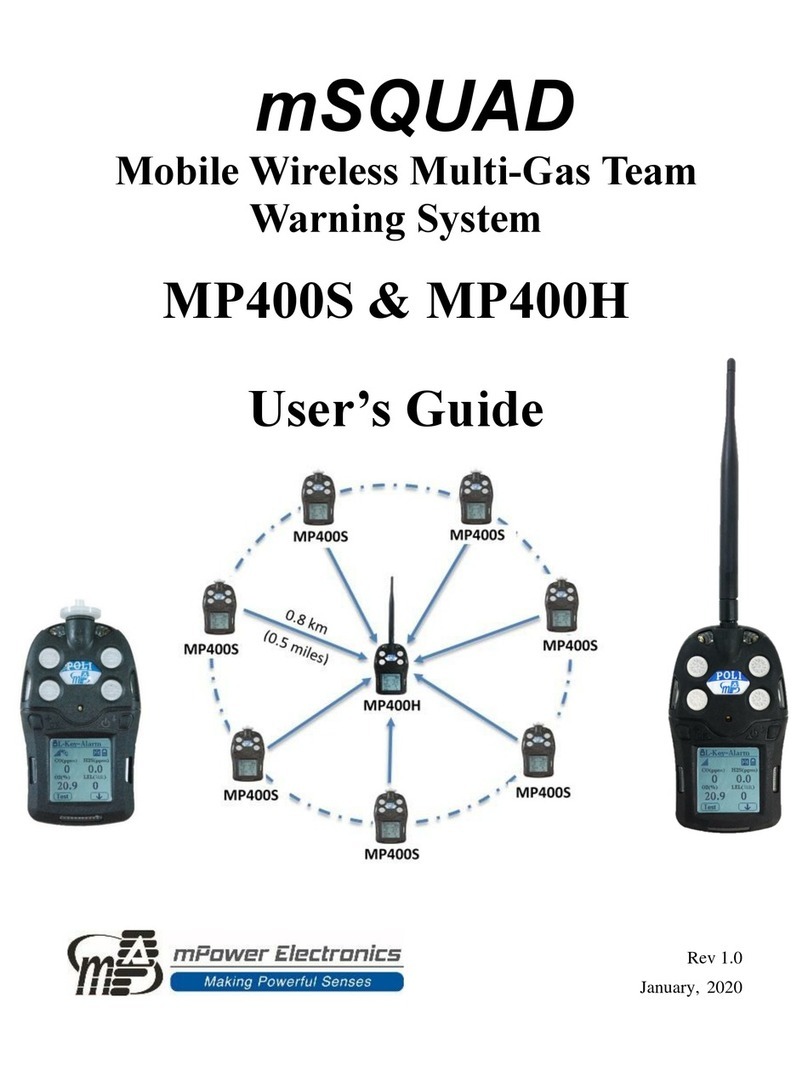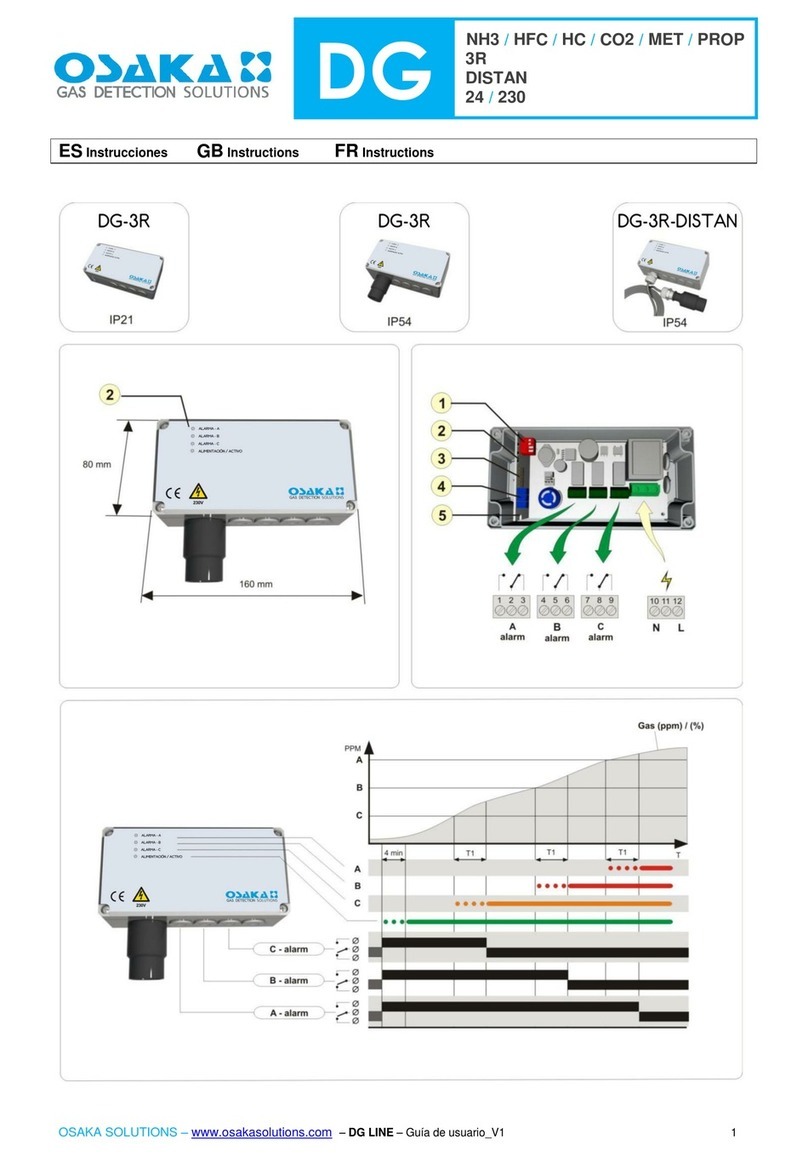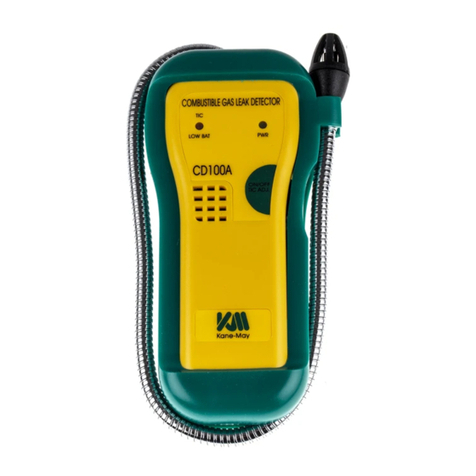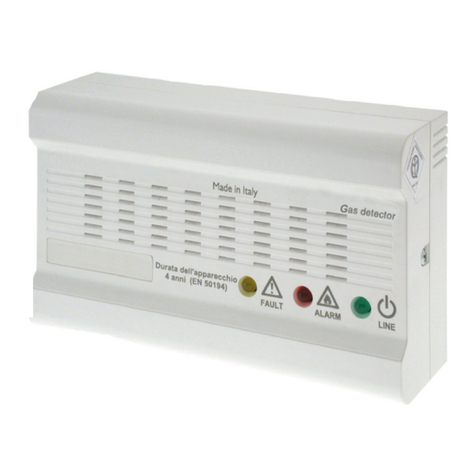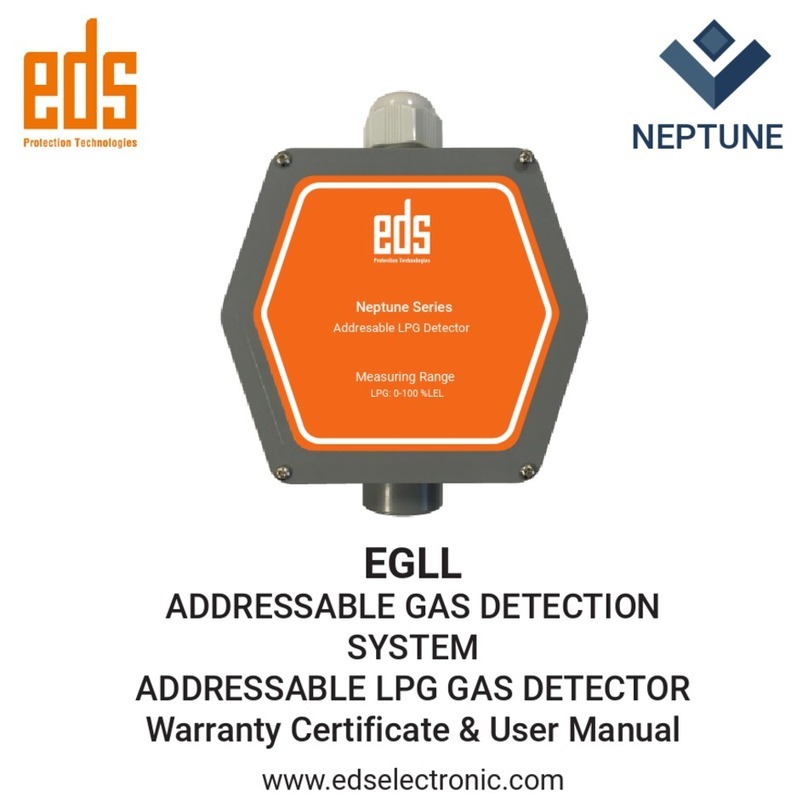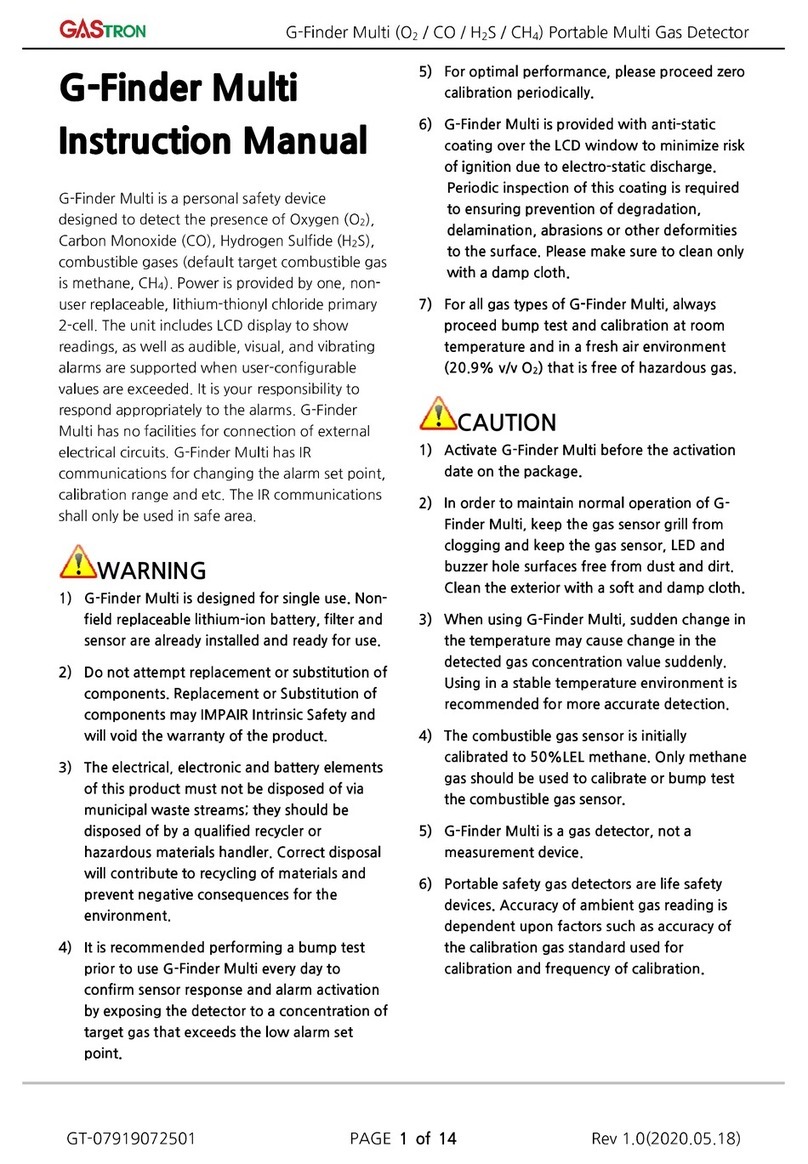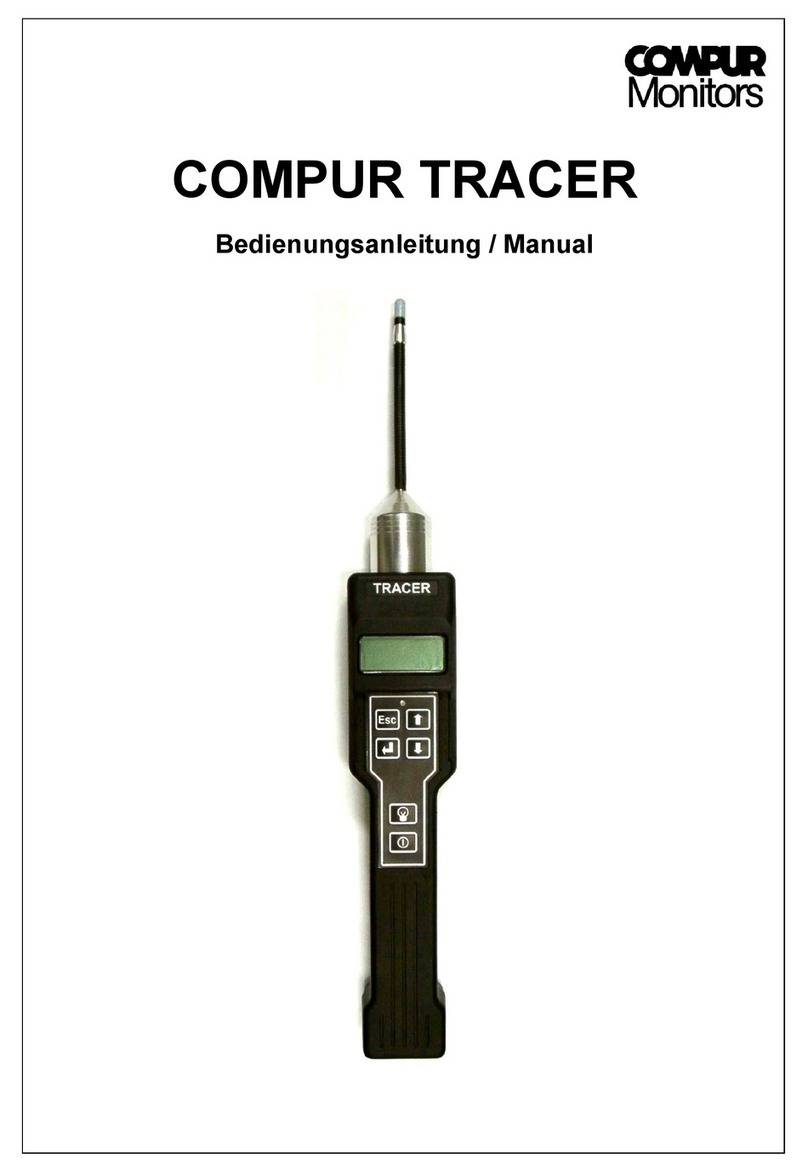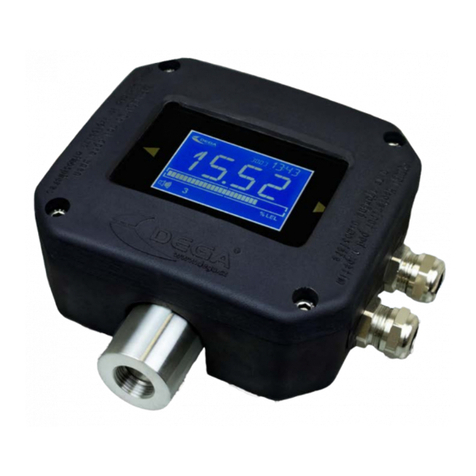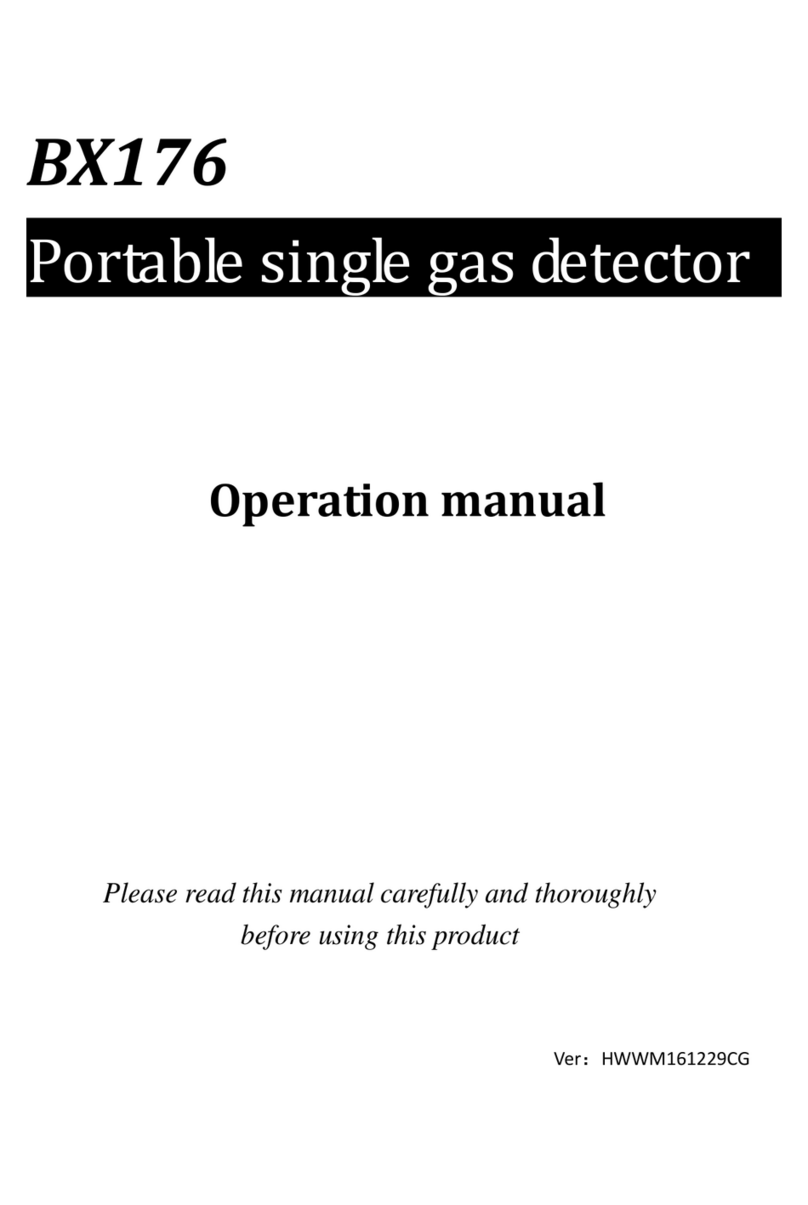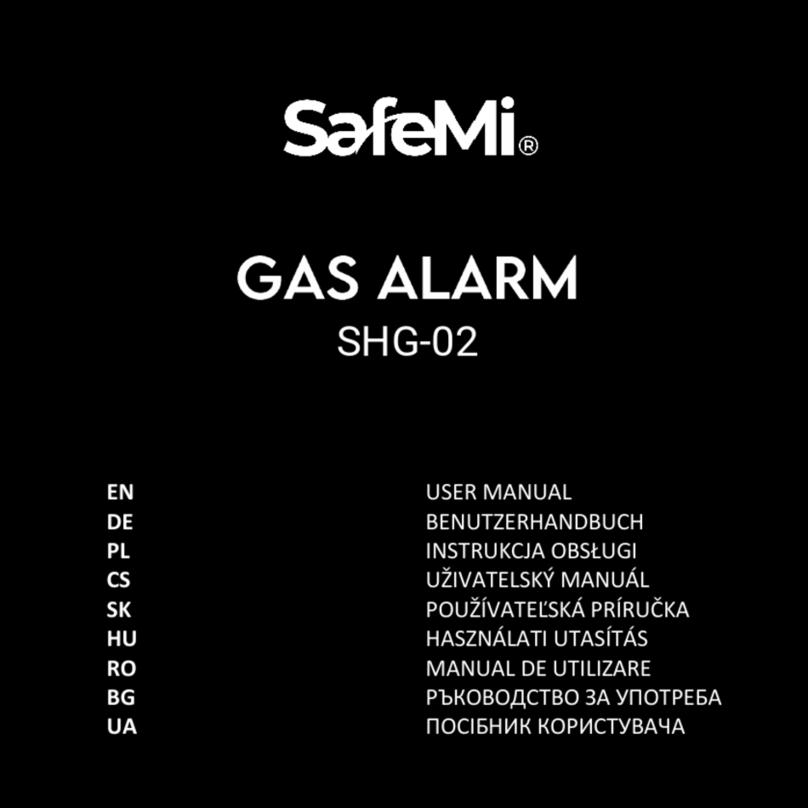Prosense BTN Series User manual

1
PRS-UM-BTN-EN-Rev02-02.2019
PROSENSE BTN Series Gas Detectors
Installation and User Manual

2
PRS-UM-BTN-EN-Rev02-02.2019
WARNING!
This manual must be carefully read by all persons who have or will have the
responsibility for installing, using or servicing this product.
Like any equipment, this product will perform as designed only if installed, used
and serviced in accordance with the manufacturer’s instructions. Otherwise, it
could fail to perform as designed and persons who rely on this product for their
safety could suffer severe personal injury or death.
The warranties made by Prosense with respect to this product are voided if the
product is not installed, used and serviced in accordance with the instructions
in this user guide. Please protect yourself and other by following them.
Important Remark
The detector has been factory-tested before delivery, the commissioning after
installation must include the zero- and span-adjustment. The commissioning
has to be terminated by a function test of the complete gas detection system.

3
PRS-UM-BTN-EN-Rev02-02.2019
CONTENTS
For Your Safety ........................................................................................................................................... 4
Strictly Follow The Instructions For Use............................................................................................. 4
Use in Areas Subject to Explosion Hazards ........................................................................................ 4
Liability For Proper Function or Damage............................................................................................ 4
Intended Use ...................................................................................................................................... 4
Introduction................................................................................................................................................ 6
Detector Body............................................................................................................................................. 6
Sensor Head................................................................................................................................................ 7
Installation.................................................................................................................................................. 7
Mounting The Detector.............................................................................................................................. 8
Cabling and Connections ............................................................................................................................ 9
BTN Series Detectors Connections........................................................................................................... 10
BTN Series Detectors Connections with RS485 Module .......................................................................... 12
System Status ........................................................................................................................................... 13
General Specification ............................................................................................................................... 15
Warranty Statement................................................................................................................................. 16

4
PRS-UM-BTN-EN-Rev02-02.2019
For Your Safety
Ensure that this Operating Manual is read and understood BEFORE installing / operating /
maintaining the equipment. Pay particular attention to Warnings and Cautions. All document
Warnings are listed here and repeated where appropriate at the start of the relevant
chapter(s) of this Operating Manual. Cautions appear in the sections/sub-sections of the
document where they apply.
Strictly Follow The Instructions for Use
Any use of the detectors requires full understanding and strict observation of these
instructions. The detector is only to be used for purposes specified here.
Use In Areas Subject To Explosion Hazards
Equipment or components which are used in potentially explosive atmospheres and have
been tested and approved according to International or European regulations may be used
only under the conditions specified here. Modifications of components or the use of faulty or
incomplete parts are not permitted. In case of repairs of equipment or components, the
national regulations must be observed.
Liability For Proper Function Or Damage
The liability for the proper function of the detector is irrevocably transferred to the owner
or operator to the extent that the detector is serviced or repaired by personnel not employed
or authorized by Prosense or if the sensing head is used in a manner not conforming to its
intended use. Prosense cannot be held responsible for damage caused by non-compliance
with the recommendations given above. The warranty and liability provisions of the terms of
sale and delivery of Prosense are likewise not modified by the recommendations given above.
Intended Use
The BTN series detectors are intended to be used for stationary, continuous monitoring for
combustible gas/air or vapour/air mixtures below the Lower Explosion Limit (LEL) resp. below
10 % of the LEL under atmospheric conditions. BTN Series detectors are suitable to use in safe
areas.
Not to be used in oxygen enriched atmospheres
In conjunction with the central controllers Prosense detectors with preadjusted
alarm thresholds audible and visible alarm devices or automatic countermeasures
can be activated before the detected gases or vapours can form dangerous
flammable mixtures with air.
Please be alerted in following special conditions may have impact on measuring function due
to the nature of measuring method:
1. Very High Gas Concentrations
Catalytic and Pellistor sensors used to dedect flammable and toxic gases. The measuring
method based on heat produced by reaction on the catalytic oxidation of a flammable gas. In

5
PRS-UM-BTN-EN-Rev02-02.2019
case of high gas concentrations there is not enough oxygen in the sensor to perform oxidation
process correctly. Hence the measuring signal decreases at high gas concentrations and even
can lead to measuring signal within the measuring range again. A connected controller must
be operated with alarm devices, outputs, and alarm thresholds operating as latched if the
measuring range is exceeded. In this case do not reset latching alarms without having ensured
a safe condition by means of an independent gas concentrations measurement.
2. Minimum Oxygen Concentration
The measuring principle of heat of reaction needs a minimum oxygen concentration of 12 %
by vol., otherwise the measuring values will be too low because of oxygen deficiency.
3. Long-term Gassing With Methane At Very Low Temperatures
If the Prosense BTN series detectors are operated applying with methane at very low
temperatures, the measuring signal at longterm exposition may decrease after alarm
activation and may lead to misinterpretation.
If a gas alarm occurs, necessary actions need to be taken immediately. The decrease of the
measuring signal should not mean that the gas concentration has been decreased. We
recommend to keep alarms on the associated controllers and not to reset these alarms
without performing measurement with an independent gaz detectors to make sure conditions
are safe.

6
PRS-UM-BTN-EN-Rev02-02.2019
Introduction
The Prosense comprises a gas detector body and a choice of sensors heads for detecting
flammable gas, toxic gas and oxygen. The construction of Prosense allows it to be used in
non-hazardous safe area locations.
Prosense detectors can be configured with a wide range of different sensors may be used to
detect a broader range of target gases. The detector provides three programmable relays
which are FAULT, ALARM1 and ALARM2 for controlling external equipment e.g. alarms,
sirens, valves or switches. The detector can be configured to communicate RS485 modbus
protocal with an optional module and also provides FAULT and ALARM1 relay outputs at
same time.
Detector Body
Prosense BTN series detectors comprises of the main parts as shown below:
Diagram 1: Exploded view
The detector enclosure has four threaded entries. The three cable entries either side of the
upper part of the transmitter housing are for connecting the power source, signal output and
relay contacts to associated signalling equipment. The bottom entry allows direct connection
of the sensor socket. The body has integrated mounting screw locations on housing.
Sensor Head
Dedector body
Body Cover
Cable entries
Sensor entry

7
PRS-UM-BTN-EN-Rev02-02.2019
Diagram 2: Detector Body and Sensor Head Size
Sensor Head
The Prosense BTN series sensor head designed to dedect flammable and toxic gases. Sensor
head may include electrocatalytic technologies or a wide range of toxic gas sensors based on
electrochemical cell (ECC) technology.
Installation
Gas detectors should be mounted where a potential hazard of gas is most likely to be present.
The following points should be noted when locating gas sensors.
•When locating detectors consider the possible damage caused by natural events e.g.
rain or flooding.
•Consider ease of access to the gas detector for functional testing and servicing.
•Consider how escaping gas may behave due to natural or forced air currents.
Note: The placement of gas detectors should be determined following the advice of experts
having specialist knowledge of gas dispersion, experts having knowledge of the process plant
system and equipment involved, safety and engineering personnel. The agreement reached
on the location of detectors should be recorded.
Each gas has different nature depending on their density. The density of which is lower than
air, such as hydrogen, methane or ammonia the sensor head must be located above a possible
leak or at the highest points at which major concentrations of gas may be found. The gases
and vapours with a density greater than air, the sensor head must be installed beneath a
possible leak or at the lowest points at which such gases and vapours may be present. The
density of which is higher than air the sensor head must be located where gas accumulate.

8
PRS-UM-BTN-EN-Rev02-02.2019
Mounting The Detector
The detector should be mounted vertically as the sensor head pointing downwards. Detector
has to be mounted such that the sensor's gas entrance area.
The install location
•should be isolated from vibration, direct sun light and have temperature stability
•avoided external influences such as splashing water, oil, corrosive aerosols
•should have at least 30 cm free space beneath the sensor head to provide accessibility
for calibration work.
•should be in air flow between possible leak or collection point and possible source of
ignition.
Prosense do not recommend to install detectors to :
•directly above a cooking unit,
•directly above a sink unit,
•close to an extractor unit,
•outdoor without protection against the rain,
•in places where temperature is outside the admissible operating range,
•in corrosive environments,
•inside air vents.
•in environments where silicon can be found.
The Prosense detector has an integrated mounting screw holes on the body. The correct
mounting position is given in Diagram 3:
Diagram 3: Mounting holes on body
Mounting hole
Mounting hole
Mounting hole

9
PRS-UM-BTN-EN-Rev02-02.2019
Cabling and Connections
Caution: All electrical connections should be made in accordance with any relevant local or
national legislation, standards or codes of practice.
Prosense BTN series detectors can operate between 12 - 24 VDC. The connection socket
located on main board. User should consider the cable lenght when performing installation in
the field. The Prosense detector requires a power supply between 12VDC and 24VDC. Make
sure that a minimum 12 VDC supply available at the detector entrance and consider the
voltage drop due to cable resistance in case of long distance applications.
The use of industrial grade, suitably shielded field cable is recommended. The best practices
shown that, screened 4 cores (plus screen 90% coverage), suitably mechanically protected
copper cable with a suitable explosion-proof gland, or ¾” NPT steel conduit, depending on the
distance between signal received or control panel and detector. It is recommended to use 1.5
mm2 (16 AWG) cable.
V+, V-(GND) ports must be connected via using two-wire cable to supply 16VDC power to
detector. If detector has RS485 communication module additional two wire cable should be
used to connect A and B to read the output signal of detector from A and B ports. Connections
should be made correctly with extra care to do not mix ports and not cause any damage on
the detectors. Detector power connection should be done with 1.5mm2 cross section cable.
The total distance between control panel and detectors should not exceed 1km.
The wiring for detectors utilized with RS485 board should be done by using connection cable
EIA RS485 2 core wires with section 0.22 / 0.35 mm2 and shielded. Nominal capacity between
the wires < 50pF/m and nominal impedance 120 Ohms.
In case RS485 communciation module used on detectors to monitor through DP32 control
panel, the V+, V- ports and A,B ports are located on different socket in both DP32 control
panel and detector side. The connections should be done with care to do not mix power and
RS485 ports. All detectors will be connected through one cable via hopping one detector to
another till the last detector on the line.
There should be one master device and up to 32 slave devices in RS485 communication. The
master is DP32 control panel and detectors will be the slave devices:
Diagram 4: RS485 communication

10
PRS-UM-BTN-EN-Rev02-02.2019
Diagram 5: Panel to detector connections
Each detector connected to DP32 panel should have unique address. Detectors having same
address would not be recognised by control panel. DP32 panel can communicate up to 32
detectors. In case less then 32 detectors connected, control panel would not show non-
existent detectors. Unused detectors should be deactivated on channel settings menu steps.
Important: The last detector at the communication line should have line termination resistor
(120 Ohm) to enable communication for all detectors on the line. The resistor is not
implemented on the board and user should connect it physically during the installation.
BTN Series Detectors Connections
BTN Series detectors has a power input and three relay output sockets on main board.
Diagram 6: BTN Series detector main board
Sensor connections are not used for external connections and should not be changed in any
case. BTN Series detectors has three integrated relays on main board which are named as
Detector 1
Detector 2
A
B
V-
V+
DP32
Panel
Max 32
Detector
V+ V-B A
V+ V-B A
A
B
V-
V+
V-
V+
ALARM1
FAULT
Sensor connection
Address and alarm level
adjustment switches
ALARM2

11
PRS-UM-BTN-EN-Rev02-02.2019
Alarm1, Alarm2 and Fault. Relays are not energised and only works as NO (Normally Open)
status. It is not possible to adjust relay activation method. Alarm1 relay will be activated when
alarm1 threshold level exceeded. If measurement level inceases Alarm2 relay activated
together with Alarm 1. Fault relay will be activated only on fault conditions. Alarm levels are
adjustable to predefined levels. Switches 6 and 7 should be used to change alarm levels.
Diagram 7: BTN Series detector alarm level adjustment switches
Alarm levels and related switch positions are given in table-3:
Switch 6
Switch 7
Alarm1
Alarm2
OFF
OFF
10
15
OFF
ON
10
20
ON
OFF
30
40
ON
ON
40
60
Table 1: BTN Series detector alarm levels
Oxygen Detectors:
For oxygen detectors the output values and meanings are different as oxygen is naturally
available in atmosphere. Alarm 1 is used to raise low level alarm and Alarm2 is used to raise
high level alarm for Oxygen. Alarm levels are also different as given in below table: Alarm
levels and related switch positions are given below:
Switch 6
Switch 7
Alarm1
Alarm2
OFF
OFF
18
23
ON
OFF
19
22
OFF
ON
18
22
ON
ON
19
23
Table 2: BTN Series Oxygen detector alarm level (% Volume) switch positions
Alarm level adjustment
switches

12
PRS-UM-BTN-EN-Rev02-02.2019
BTN Series Detectors Connections with RS485 Module
When RS485 module installed on BTN series detectors the ALARM2 relay ports will be
converted to RS485 ports automatically. The detector can still provide fault and alarm relays
with RS485 communication module.
Diagram 8: BTN Series detector with RS485 module
Important: The last detector at the communication line should have line termination resistor
(120 Ohm) to enable communication for all detectors on the line. The resistor is not
implemented on the board and user should connect it physically during the installation
between RS485A and RS485B ports.
BTN series detector main board has a dip-switch to assign address to the detector. Each
detector must have unique address to communicate to DP32 Panel. Detectors having same
address would not be recognised by the panel. The address should be set via using first 5
switches on the dip-switch.
Diagram 9: BTN Series detector address switches
Detectors will be wired in daisy chain (bus) mode. We recommend not to use star mode
connection due to negative impact of interference. Each detector should have uniqe address
number in the chain. The detectors would not be recognised by control panel if same address
V-
V+
RS485 B
RS485 A
ALARM1
FAULT
Sensor connection
Adres and alarm level
adjustment switches
RS485 communication module
Address switches

13
PRS-UM-BTN-EN-Rev02-02.2019
given to them. The address of detector can be adjusted via using DIP-Switch set on the board:
Diagram10: RS485 Modbus serial communication address and switch position
Important : Only the last detector on the serial bus should have end of line resistor.
System Status
Prosense BTN Series detectors has two LEDs on main board. Red LED shows system power
status and yellow LED shows fault status. Both LEDs will start blinking right after power
applied. After appoximitly 90 sec the yellow LED will be turned of and only red LED will
continue blinking. This status means that detector is ready to normal operation.
First time switch on (Commissioning)
WARNING
The following procedure requires the detector cover to be removed while carrying out supply
voltage checks. Therefore the appropriate permits to work should be sought in preparation.
Prior to carrying out any HOT WORK ensure local and site procedures are followed. Ensure
that the associated control panel output actuation is inhibited so as to prevent false alarms.
Caution: The following procedure should be followed carefully and only performed by
suitably trained personnel
1. Remove the detector cover
2. Make sure the detector's output and power input connections done correctly
3. Check that all electrical connections are terminated correctly

14
PRS-UM-BTN-EN-Rev02-02.2019
4. Switch On the external power supply to feed the detector. If it is connected to DP32 Panel,
cables should be installed according to DP32 Panel user manual as panel can provide both
power and communication connections to the detectors.
5. Using a Digital Multi Meter (DMM), check the Supply Voltage at the terminals V+ and V-
this should be a minimum supply voltage of 12VDC (Maximum supply voltage is 24VDC).
6. Check LED status on detector main board. LED status should be like explained above after
appying power depending of the detector model.
7. Wait two minutes and confirm detector LED status pointing normal operation. If detectors
used with DP32 Panel, panel should recognise each detector correctly at their addresses.
8. Switch Off the external power to the detector.
9. Fit the cover and make sure non of the cables cause an obstruction while fitting cover
10. Switch on external power to the detector or panel if used.
Calibration
It is recommended to periodically carry out calibration to ensure correct operation.
Calibration should be done by a person who trained and certified by local or international
authorities.
Detector should be powered and stabilized for at least 30 minutes before calibration. For
Flammable gas calibration use a calibration gas concentration of between 25%LEL and
75%LEL to ensure that the required accuracy can be attained. To calibrate the detector, use
an appropriate span gas cylinder, constant flow regulator and Prosense Gas Cap. The flow
rate used for calibration gas is 0.5 L/Min.
Important: Any optional board is installed on detector should be removed prior the
calibration as some of the features masked or unavailable with them when installed.
Zero Calibration
It is recommended to use a compressed air cylinder (20.9%Vol oxygen) to perform the zero
calibration if the area where the detector is located contains any residual amount of the
target gas. If no residual gas is present then the background air can be used to perform the
zero calibration. To perform Zero calibration put a jumper to Z pins on detector main board
and press Zero button for 3 seconds. The zero level will be automatically adjusted.
Span Calibration
As there is only relay outputs and RS485 communication ports availabale on detector it is
necesssary to use a control panel to see gas measurement of the detector during the span
calibration. If RS485 communication is not possible calibration should be done ina service
center. To perform Span calibration apply gas to detector via using the Gas Cap while
detector is energised and working. The signal level vary depending on the used gas for
calibration and gas concentration. If the measured level is lower than the calibration gas
level, put a jumper to S+ pin press to Span button till the level reaches the necessarly value.
If the measurement level is higher than the necessary value, put a jumper to S- pin and press

15
PRS-UM-BTN-EN-Rev02-02.2019
to Span button till the level reaches the necessarly value. Once the span calibration
completed remove the jumper and put as a spare on to detector board.
Important: Never put jumper on both S+ and S- pins and press any button.
Diagram 11: Calibration buttons and pins
General Specification
BTN Series Detector Electrical Specifications:
Input Voltage Range
12 to 20VDC (16VDC nominal)
Max Power Consumption
0.96 Watts at 16VDC - normal condition
1.60 Watts at 16VDC - alarm and fault condition
Terminals
4 x 2 x screw terminals suitable for wire diameter 1.5mm2 to 2.5mm2
Relays
3 x (1A 30VDC, 0.5A 125VAC, 0.3A 80VDC).
Non-selectable: normally open and de-energized
Communication
RS485, Modbus RTU
Sensor
Catalytic
Table 2: BTN Series detectors electrical specifications
Detector Body Specifications:
Material
Plastic (black)
Weight
Plastic buat: 230g (with Sensor Header)
Mounting
Wall mounting
Entries
PG11
Table 3: Detector body specifications
Environmental:
IP Rating IP54 (plastic buat)
Operating Temperature -10ºC to +50ºC / 14ºF to +120ºF
Operating Humidity
Continuous 20-90%RH (non condensing)
Operating Pressure 90-110kPa
Storage Conditions -10°C to +50°C (14°F to +120°F)
Table 4: Environmental specifications
Span (S) and Zero (Z) buttons
Span (S+ , S-) and Zero (Z) pins

16
PRS-UM-BTN-EN-Rev02-02.2019
Warranty Statement
All products are designed and manufactured to the latest internationally recognized standards
by Prosense Technology under a Quality Management system that is certified to ISO 9001. As
such Prosense Technology warrants its products against defective parts and workmanship and
will repair or (at its option) replace any instruments which are or may become defective under
proper use within 12 months from date of commissioning by an approved Prosense
Technology representative or 18 months from date of shipment from Prosense Technology,
whichever is the sooner. This warranty does not cover disposable batteries or damage caused
by accident, abuse, abnormal operating conditions or poisoning of sensor.
Defective goods must be returned to Prosense Technology premises accompanied by a
detailed description of any issue. Where return of goods is not practicable Prosense
Technology reserves the right to charge for any site attendance where any fault is not found
with he the equipment. Prosense Technology shall not be liable for any loss or damage
whatsoever or howsoever occasioned which may be a direct or indirect result of the use or
operation of the Contract Goods by the Buyer or any Party.
This warranty covers instrument and parts sold to the Buyer only by authorized distributors,
dealers and representatives as appointed by Prosense Technology. The warranties set out in
this clause are not pro rata, i.e. the initial warranty period is not extended by virtue of any
works carried out there under.
In no event will Prosense Technology be liable for any incidental damages, consequential
damages, special damages, punitive damages, statutory damages, indirect damages, loss of
profits, loss of revenues, or loss of use, even if informed of the possibility of such damages.
Prosense Technology's liability for any claims arising out of or related to this product will in no
case exceed the order value. To the extent permitted by applicable law, these limitations and
exclusions will apply regardless of whether liability arises from breach of contract, warranty,
tort (including but not limited to negligence), by operation of law, or otherwise.
Table of contents
Other Prosense Gas Detector manuals
Popular Gas Detector manuals by other brands

Riken Keiki
Riken Keiki SD-1DEC operating manual

RKI Instruments
RKI Instruments 35-3001A-05 Series Operator's manual

Dräger
Dräger X-am 3500 Instructions for use
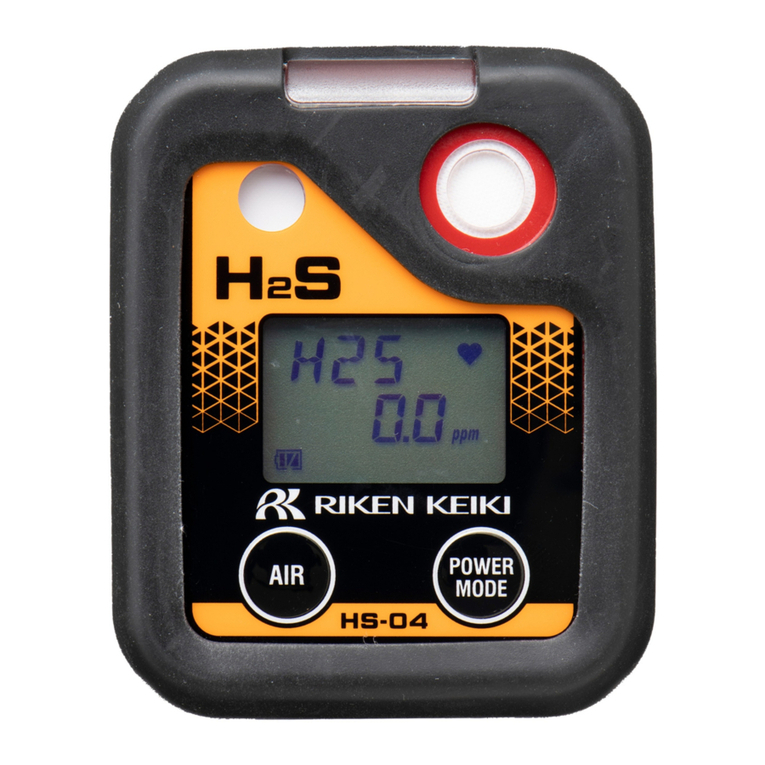
Riken Keiki
Riken Keiki 04 Series Operation manual
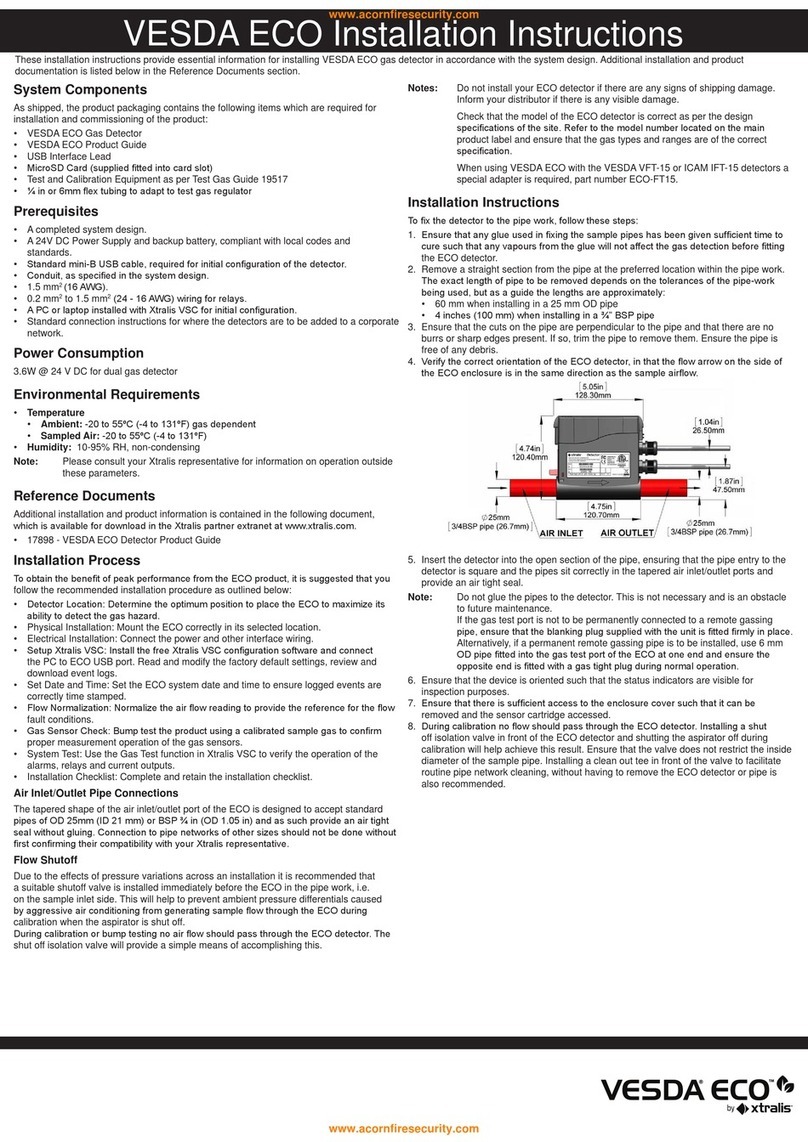
Xtrails
Xtrails VESDA ECO installation instructions
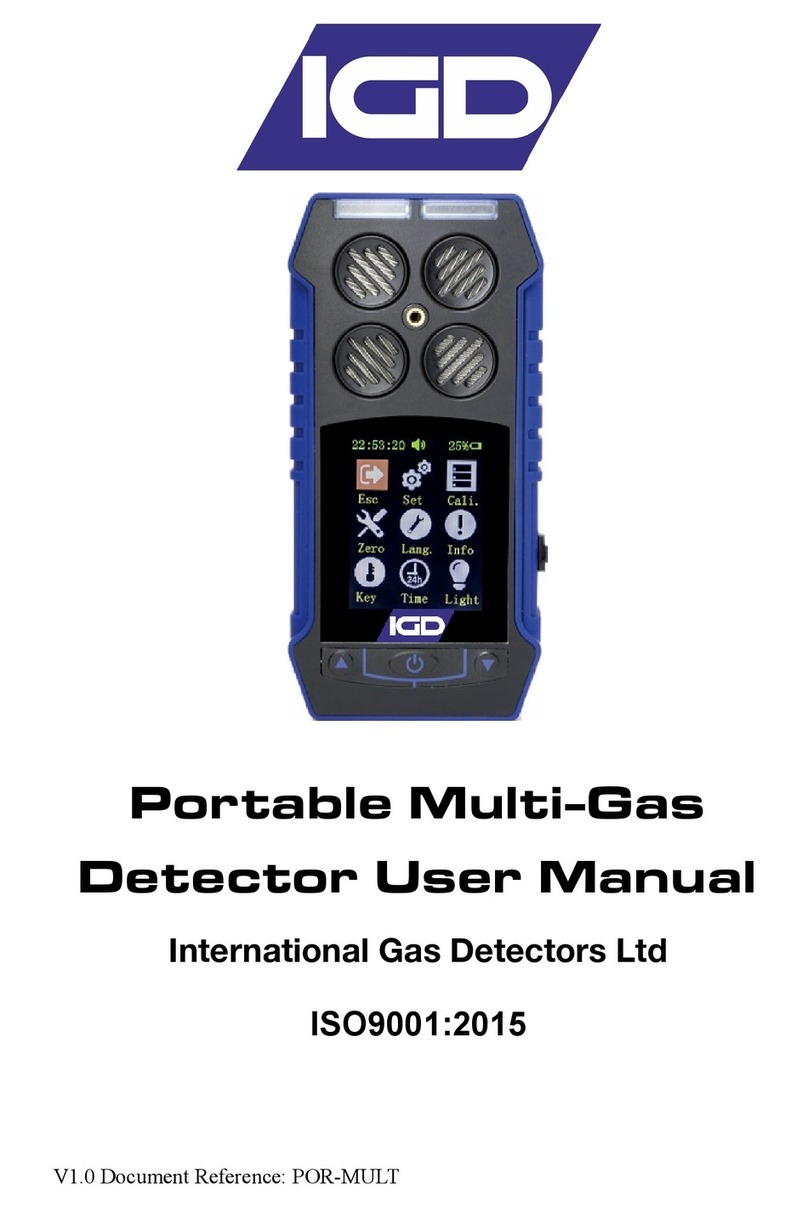
International Gas Detectors
International Gas Detectors POR-MULT user manual
